Table of Contents
Introduction
In foreknown you can manage not only the orders themselves but also their budgets. This way you always have an overview of the budget amount and it can be recognized if it is exceeded or undershot in order to be able to contact the customer at an early stage.
The budget management is accessible via the menu item " Offers & Orders / Budgets" for users with the role "Account Manager".
Manage Budgets
In the budget management of foreknown you get an overview of all budgets. In addition, there is the possibility to search for specific budgets, filter the budget list, create new budgets or edit existing budgets.
Search Budget
Selecting the "Budgets" menu item from the main menu will bring up the following dialog:
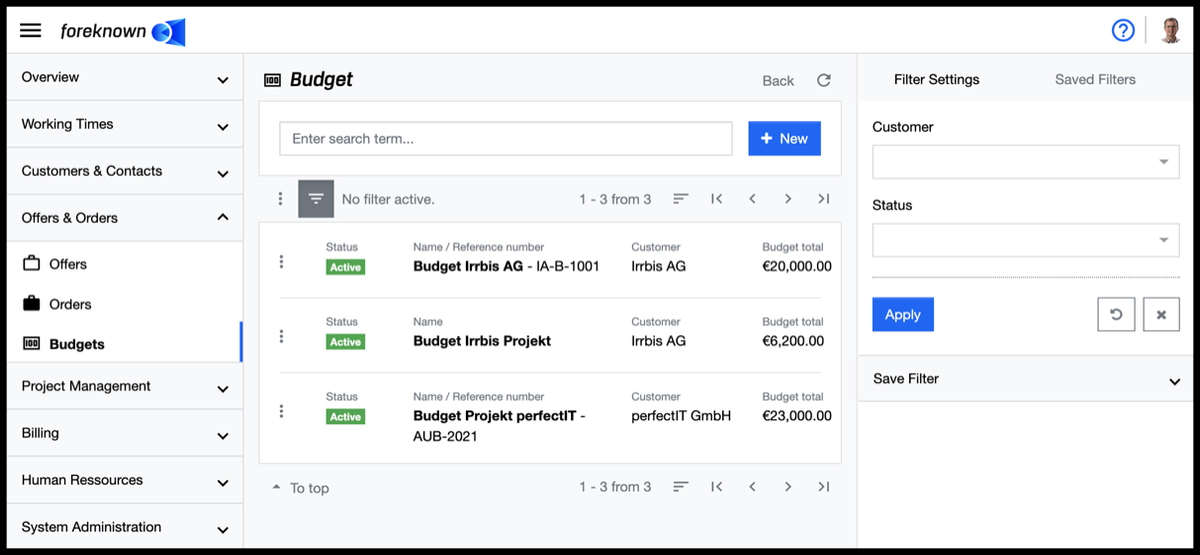
In the upper area of the dialog is the search field and the "+ New" button (see also Create Budget). Below this area all already created budgets are displayed in form of a list, which can be scrolled, filtered and sorted.
If you enter a search term in the input field, the list will only show the budgets that contain the entered search term in the name or reference number. In this way, individual budgets can be found quickly and opened for editing.
Filter Budgets
In addition to the search function, budget management also offers a filter dialog. The filter dialog is always located in foreknown as a fold-out dialog on the right side. The filter dialog can be expanded and collapsed by clicking on the button with the three dashes above the list on the left.
The following filter options are offered for budgets:
- Customer: A customer can be searched and selected via a field with auto-completion.
- Status: Via a field with auto-completion one or more statuses can be selected.
Using the action "Apply", all budgets in the list that match the filter criteria will be displayed. The "x" action removes all filter settings and the list shows all budgets again. The "Reset" action (icon: arrow in a circle) discards all changes that may have been made to a saved filter.
For general information about the filter options, see also chapter Basics: Filters.
Create Budget
To create a new budget, click on the "+ New" button located at the top right of the search box. This button will open the "Create Budget" popup dialog.
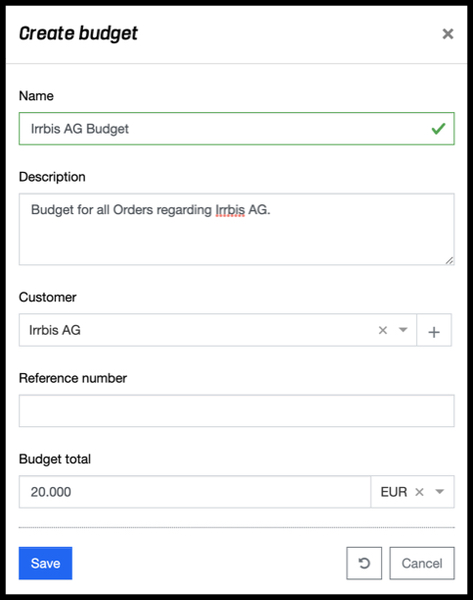
The following properties must/can be specified for a new budget:
- Name: A name for the budget must be specified here.
- Description: Additional information about the budget can be specified here.
- Customer: Here you have to select the appropriate customer from a drop-down list with auto-completion. Via the "+" in the line a new customer can be created directly.
- Reference Number: If available, the reference number for the budget can be entered here.
- Budget Sum: Here the sum of the budget and the currency are defined.
With the action "Save" a new budget is created. With the action "Reset" and "Cancel" the entries are discarded and in case of the action "Cancel" the dialog is closed.
Edit Budget
To edit the data of a budget, it is possible to click on the action menu (Three dots at the beginning of the line) and then "Edit budget". This opens the "Edit Budget" dialog, where all properties from the "Create Budget" dialog can be edited. Furthermore, the same dialog can be opened via the detailed view of the budget and then the button with the "pencil icon".
To delete a budget, click on the action menu and then on "Delete budget". If you confirm with " Delete" in the following dialog, the budget will be irrevocably deleted.
Change Status
If you want to change the status of a budget, you can also do this via the "Edit Budget" dialog. Here you can choose between "Active" and "Inactive".
Orders
Overview
In the detailed view of a budget, the tab "Orders" can be found below the master data. Here the already assigned orders are displayed in the form of a list. In the list view, the order status, the order number and the description as well as the net total of the order are displayed.
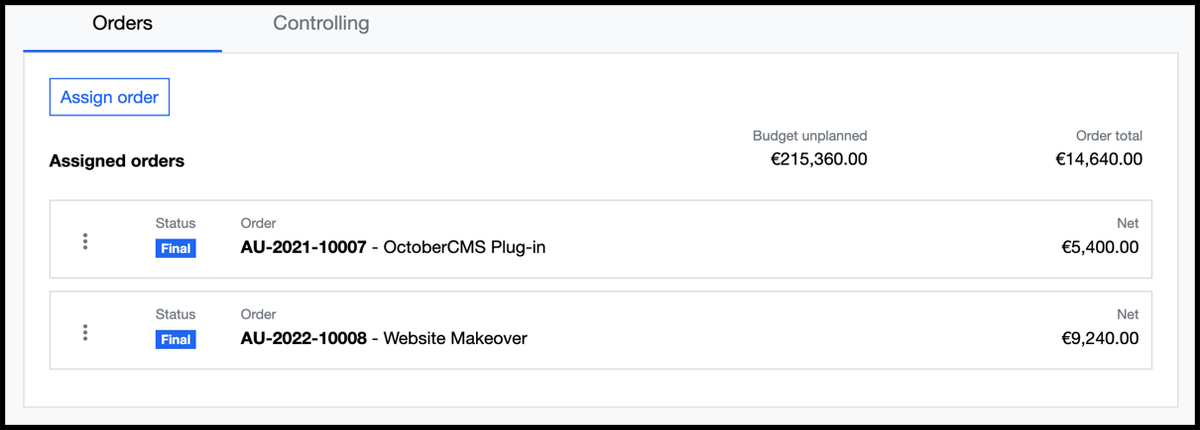
Above the list, the total of all orders is displayed on the one hand, and on the other hand, you are shown how much budget is still available. The latter is marked in color as follows:
Unplanned Budget(Black): The indicated sum can still be planned for orders.
Budget consumed(Green): If the budget is completely consumed, this is shown in green.
Budget overplaned(Red): If the order total exceeds the budget, the amount is displayed in red.
Assign Order
To assign an order to the budget, you have to click on the "Assign Order" button on the left above the list. This will open the "Assign Order" dialog.
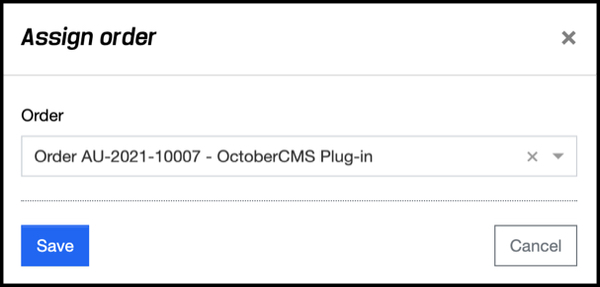
Here, an order can be selected from all orders of the customer assigned to the budget via a drop-down menu.
With the action "Save" the selected order is assigned. With the action "Cancel" the entries are discarded and the dialog is closed.
Controlling
General Key Figures
Below the "Controlling" tab is the "General KPIs" section. Here important KPIs related to the budget are displayed.

Budget: This shows as a percentage how much of the budget has already been consumed by billable services.
- Target: Shows the total amount of the budget.
- Actual: Shows the amount currently consumed.
- Remainder: Shows the amount of budget still available.
Effort: This shows in percent how much effort in hours has already been consumed by billable services.
- Target: Here the sum of all consumed efforts from the assigned orders in hours is displayed.
- Actual: Displays the total of all billable efforts from the assigned orders in hours.
- Remaining: Displays the difference in hours between the target and actual values.
Invoicing: The percentage of the billable services of the assigned orders, which have already been transferred to an invoice, is displayed here.
- Target: Shows the total amount of the budget.
- Actual: Shows the amount currently invoiced.
- Remaining: Displays the amount of the budget that has not yet been invoiced.
Burn Rate: The average consumption per day is displayed here. This is determined on the basis of existing service entries of the assigned orders and takes into account a maximum of two previous months. Depending on the available services, as much data as possible is used to calculate the burn rate. If there is not enough data available, a question mark is displayed and "Not enough data" appears under basis.
- Effort: Here is displayed how much time on average per day was booked on the budget.
- Base: The duration from which the burn rate was calculated is displayed here.
- Forecast: This shows the date on which the project budget is expected to be used up, taking into account the burn rate.
Burn-Down Chart
The Burn-Down Chart provides you with a graphical representation of the following information:
- The blue, solid line shows the actual budget consumption, which results from the billable services.
- The yellow, solid line shows the linear progression of the determined burn rate for the period of the calculation.
- The yellow, dotted line shows the linear progression of the burn rate from the end of the calculation period and represents the projected course of the budget based on the burn rate.
- The vertical orange line with the "Forecast" label indicates the point in time from which the forecast based on the burn rate will be applied.
- the vertical gray line with the "Today" label indicates the current date by which theoretically service entries could be available.
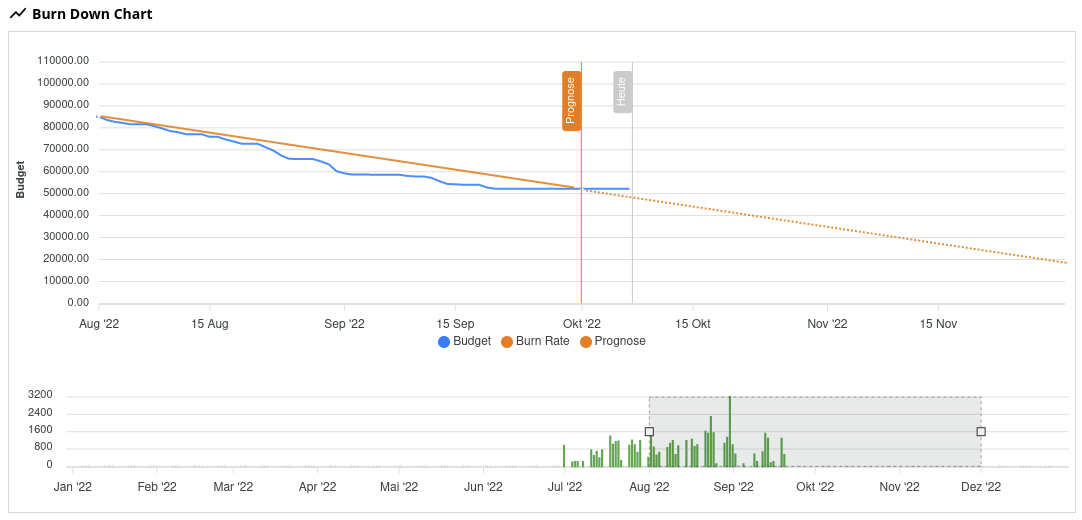
Below the line chart is a bar chart, which shows the billable service entries on a time axis. The time period can be changed with the mouse via a gray selection box. This also affects the data shown on the line chart. The selection box can also be moved on the time axis.
Note: The period used for the calculation of the burn rate does not include the current month, since this could still be incompletely maintained, e.g. because working times have not yet been booked or services have not yet been transferred, and thus the burn rate would be too low. Therefore the forecast period does not start at the "Today" line, but at the "Forecast" line.
Consumption per order item and service type
In order to be able to recognize how the consumptions are distributed the efforts of all booked billable services are broken down into order positions and service types in tabular form.
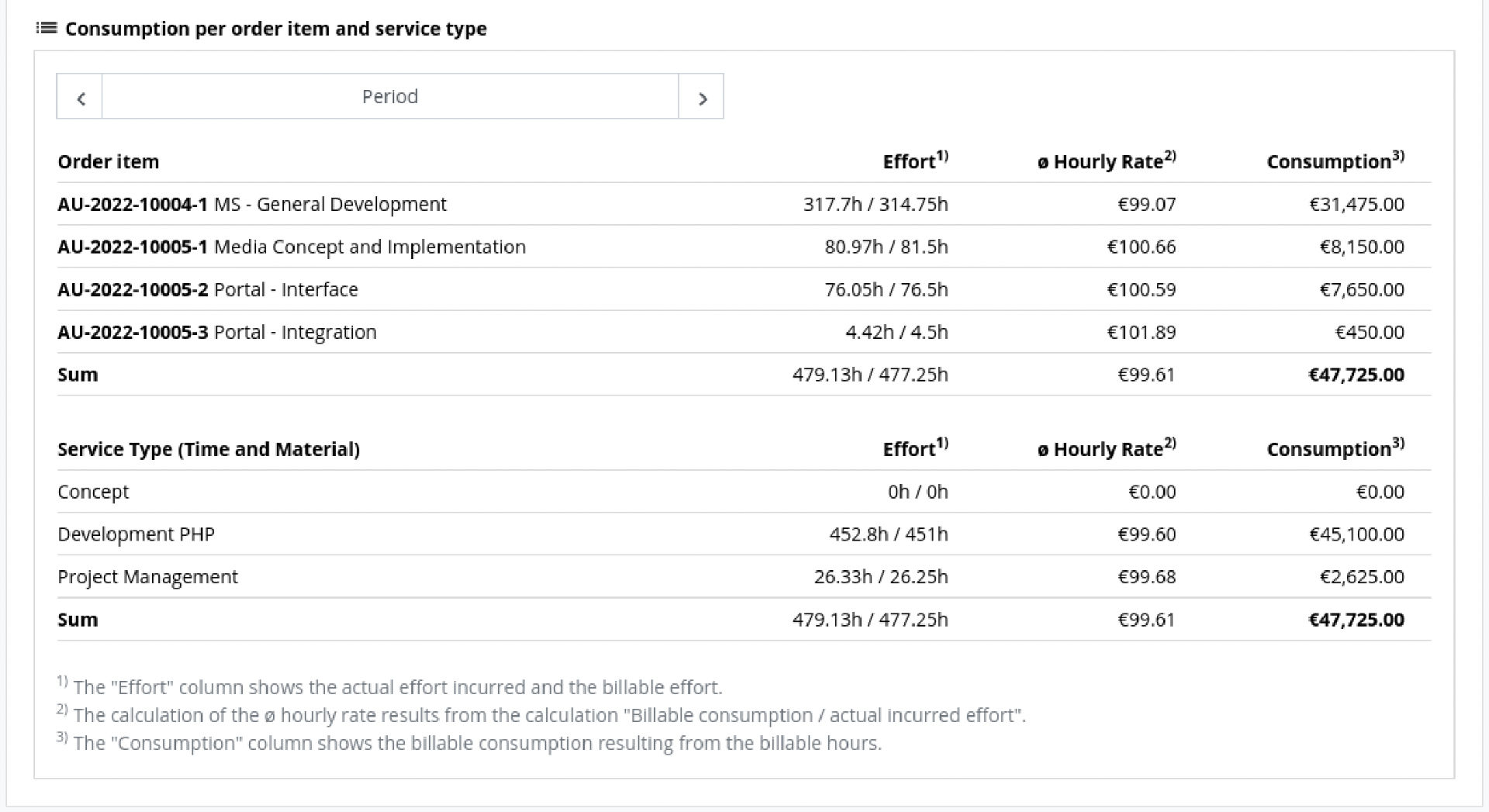
Order Positions
All assigned order items of the project are displayed here with the following information and key figures. are displayed.
- Order Position: The order number with position number and description is displayed here. A link can be used to go directly to the "Controlling" tab of the related order.
- Effort: This column shows the actual and billable effort.
- ø Hourly Rate: The calculation of the ø hourly rate results from the calculation "Billable Consumption / Actual Effort".
- Consumption: This column shows the billable amount resulting from the billable hours.
Another line shows the totals for all columns.
Service Types
Here all service types are listed consolidated over all assigned order positions. If a project has both, fixed price positions and time & material positions, these are consolidated in two tables separately. The following information is displayed per service type.
- Service Type: Name of the service type
- Effort: This column shows the actual effort incurred and the billable effort.
- ø Hourly Rate: The calculation of the ø hourly rate results from the calculation "Billable Consumption / Actually Effort".
- Consumption: This column shows the billable amount resulting from the billable hours.
Another line shows the totals for all columns.
